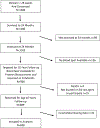Neonatal Cranial Ultrasound Findings among Infants Born Extremely Preterm: Associations with Neurodevelopmental Outcomes at 10 Years of Age
- PMID: 34090894
- PMCID: PMC8478718
- DOI: 10.1016/j.jpeds.2021.05.059
Neonatal Cranial Ultrasound Findings among Infants Born Extremely Preterm: Associations with Neurodevelopmental Outcomes at 10 Years of Age
Abstract
Objective: To examine the association between neonatal cranial ultrasound (CUS) abnormalities among infants born extremely preterm and neurodevelopmental outcomes at 10 years of age.
Study design: In a multicenter birth cohort of infants born at <28 weeks of gestation, 889 of 1198 survivors were evaluated for neurologic, cognitive, and behavioral outcomes at 10 years of age. Sonographic markers of white matter damage (WMD) included echolucencies in the brain parenchyma and moderate to severe ventricular enlargement. Neonatal CUS findings were classified as intraventricular hemorrhage (IVH) without WMD, IVH with WMD, WMD without IVH, and neither IVH nor WMD.
Results: WMD without IVH was associated with an increased risk of cognitive impairment (OR 3.5, 95% CI 1.7, 7.4), cerebral palsy (OR 14.3, 95% CI 6.5, 31.5), and epilepsy (OR 6.9; 95% CI 2.9, 16.8). Similar associations were found for WMD accompanied by IVH. Isolated IVH was not significantly associated these outcomes.
Conclusions: Among children born extremely preterm, CUS abnormalities, particularly those indicative of WMD, are predictive of neurodevelopmental impairments at 10 years of age. The strongest associations were found with cerebral palsy.
Keywords: extreme prematurity; intraventricular hemorrhage; neurodevelopmental outcomes; perinatal brain injury; ultrasound; white matter injury.
Copyright © 2021 Elsevier Inc. All rights reserved.
Figures


Comment in
-
Neuroimaging of the Preterm Brain: Review and Recommendations.J Pediatr. 2021 Oct;237:276-287.e4. doi: 10.1016/j.jpeds.2021.06.014. Epub 2021 Jun 17. J Pediatr. 2021. PMID: 34146549 No abstract available.
References
-
- Johnson S, Fawke J, Hennessy E, Rowell V, Thomas S, Wolke D, et al.Neurodevelopmental Disability Through 11 Years of Age in Children Born Before 26 Weeks of Gestation. Pediatrics. 2009;124(2):E249–E57. - PubMed
-
- Johnson S, Hennessy E, Smith R, Trikic R, Wolke D, Marlow N. Academic attainment and special educational needs in extremely preterm children at 11 years of age: the EPICure study. Archives of Disease in Childhood-Fetal and Neonatal Edition. 2009;94(4):F283–F9. - PubMed
-
- Johnson S, Hollis C, Kochhar P, Hennessy E, Wolke D, Marlow N. Psychiatric Disorders in Extremely Preterm Children: Longitudinal Finding at Age 11 Years in the EPICure Study. Journal of the American Academy of Child and Adolescent Psychiatry. 2010;49(5):453–63. - PubMed
-
- Stewart AL, Reynolds EO, Hope PL, Hamilton PA, Baudin J, Costello AM, et al.Probability of neurodevelopmental disorders estimated from ultrasound appearance of brains of very preterm infants. Dev Med Child Neurol. 1987;29(1):3–11. - PubMed
-
- Pinto-Martin JA, Whitaker AH, Feldman JF, Van Rossem R, Paneth N. Relation of cranial ultrasound abnormalities in low-birthweight infants to motor or cognitive performance at ages 2, 6, and 9 years. Dev Med Child Neurol. 1999;41(12):826–33. - PubMed
Publication types
MeSH terms
Grants and funding
LinkOut - more resources
Full Text Sources
Medical

